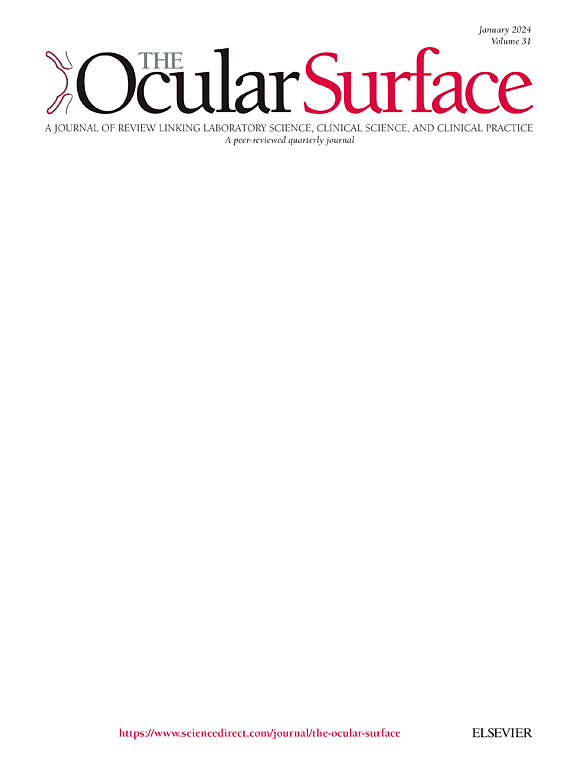Preventing and treating neurotrophic keratopathy by a single intrastromal injection of AAV-mediated gene therapy
IF 5.9
1区 医学
Q1 OPHTHALMOLOGY
引用次数: 0
Abstract
Purpose
Neurotrophic keratopathy (NK) is a degenerative corneal condition resulting from corneal nerve injury. Current therapies, including the recombinant human nerve growth factor (rhNGF) therapy, requires continuous administration. This study aims to develop a novel and highly effective gene therapy strategy for the prevention and treatment of NK.
Methods
Adeno-associated virus (AAV) was transduced into corneal stromal cells by intrastromal injection. Three dimensional corneal wholemount imaging with co-immunostaining of ZO-1 and tubulin was utilized to assess the transduction of AAV.rh10. The efficacy of prevention and treatment of NK by a single intrastromal injection of AAV-Ngf was tested using capsaicin mouse model, herpes simplex keratitis (HSK) model, type Ⅱ diabetes model and alkali burn model. rhNGF eye drops served as the positive control.
Results
Intrastromal injection of AAV.rh10 efficiently transduced the subepithelial nerve plexus and retrogradely transported to the trigeminal ganglion (TG). A single injection of AAV.rh10-Ngf can significantly promote corneal nerve repair, accelerate corneal epithelial repair, reduce corneal stromal edema, and improve corneal sensitivity across the four NK models. The therapeutic effects were consistent with those achieved by continuous administration of rhNGF drops by 6 times daily.
Conclusions
This proof-of-concept study demonstrates that AAV.rh10-Ngf gene therapy is a promising method for preventing and treating of NK. Our results underline the potential for developing clinical trials to further explore the safety and efficacy of such gene therapy.
通过一次性腹腔注射 AAV 介导的基因疗法预防和治疗神经营养性角膜病。
目的:神经营养性角膜病(NK)是一种由角膜神经损伤引起的角膜退行性病变。目前的疗法,包括重组人神经生长因子(rhNGF)疗法,需要持续给药。本研究旨在开发一种预防和治疗 NK 的新型高效基因治疗策略:方法:通过基质内注射将腺相关病毒(AAV)转入角膜基质细胞。方法:将腺相关病毒(AAV)通过基质内注射转导到角膜基质细胞中,利用三维角膜全层成像和 ZO-1 与微管蛋白的联合免疫染色来评估 AAV.rh10 的转导情况。在辣椒素小鼠模型、单纯疱疹性角膜炎(HSK)模型、Ⅱ型糖尿病模型和碱烧伤模型中测试了一次性鞘内注射 AAV-Ngf 预防和治疗 NK 的疗效,rhNGF 滴眼液作为阳性对照:结果:AAV.rh10的鞘内注射能有效转导上皮下神经丛,并逆行转运至三叉神经节(TG)。在四种 NK 模型中,单次注射 AAV.rh10-Ngf 可显著促进角膜神经修复、加速角膜上皮修复、减轻角膜基质水肿并提高角膜敏感性。这些治疗效果与每日6次持续滴注rhNGF所取得的效果一致:这项概念验证研究表明,AAV.rh10-Ngf 基因疗法是一种预防和治疗 NK 的有效方法。我们的研究结果凸显了开展临床试验以进一步探索此类基因疗法的安全性和有效性的潜力。
本文章由计算机程序翻译,如有差异,请以英文原文为准。
求助全文
约1分钟内获得全文
求助全文
来源期刊

Ocular Surface
医学-眼科学
CiteScore
11.60
自引率
14.10%
发文量
97
审稿时长
39 days
期刊介绍:
The Ocular Surface, a quarterly, a peer-reviewed journal, is an authoritative resource that integrates and interprets major findings in diverse fields related to the ocular surface, including ophthalmology, optometry, genetics, molecular biology, pharmacology, immunology, infectious disease, and epidemiology. Its critical review articles cover the most current knowledge on medical and surgical management of ocular surface pathology, new understandings of ocular surface physiology, the meaning of recent discoveries on how the ocular surface responds to injury and disease, and updates on drug and device development. The journal also publishes select original research reports and articles describing cutting-edge techniques and technology in the field.
Benefits to authors
We also provide many author benefits, such as free PDFs, a liberal copyright policy, special discounts on Elsevier publications and much more. Please click here for more information on our author services.
Please see our Guide for Authors for information on article submission. If you require any further information or help, please visit our Support Center
 求助内容:
求助内容: 应助结果提醒方式:
应助结果提醒方式:


